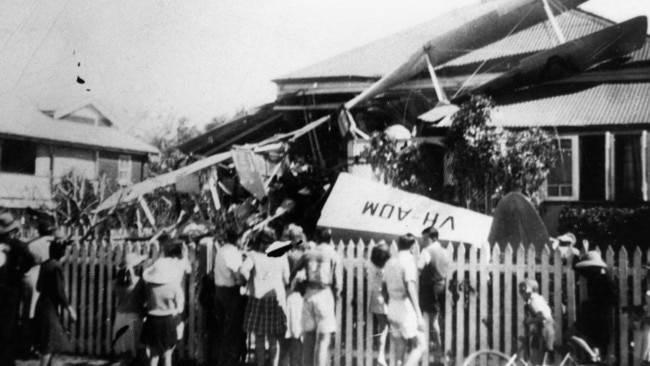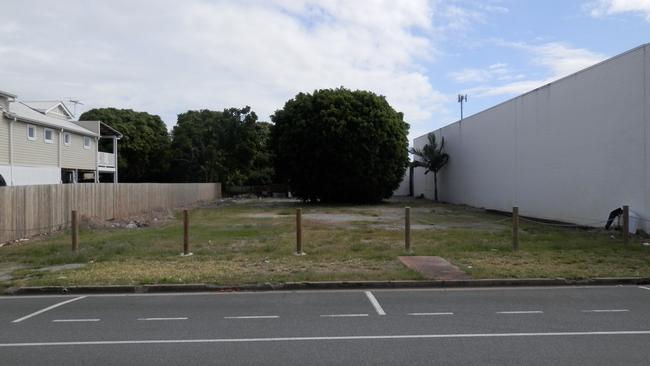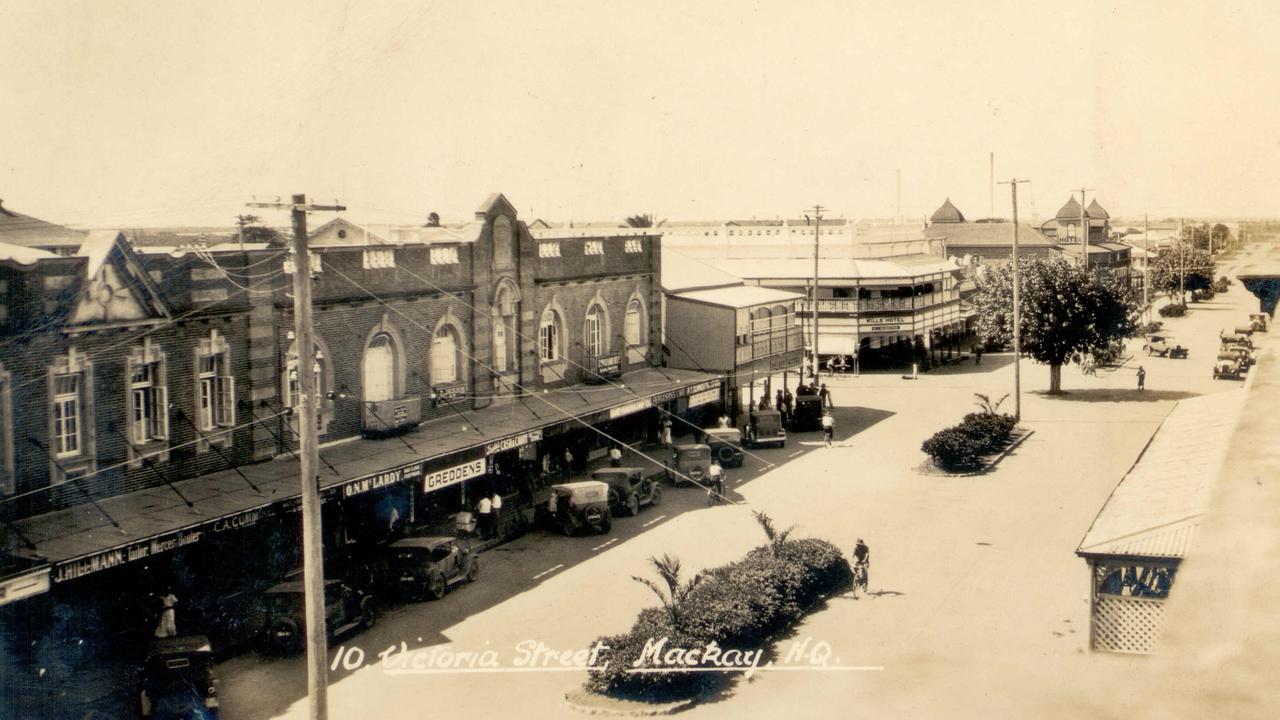Remembering the double fatal plane crash along Peel St in Mackay 75 years on
The pilot crash-landed the plane almost directly in front of the mayor’s home ending in ‘a mass of twisted metal, and splintered woodwork and glass’.

Mackay
Don't miss out on the headlines from Mackay. Followed categories will be added to My News.
Nearly 75 years ago, on Saturday July 20, 1946 the residents of Peel St had a terrifying experience when a plane attempting an emergency landing crashed into Barry’s Flats.
The aircraft involved in the accident was a seven seater, Twin-Engine Dragon Rapide DH84 ‘VH-AUM’.
This British built de Havilland 1930s short haul biplane airliner was considered an “economical and durable craft despite its relatively primitive plywood construction”.
The Mackay pilot Raymond Thomas Knight, aged 24, was highly experienced and had previously served as flight-lieutenant in the Royal Australian Air Force 76 Squadron.
Raymond, who was killed in the crash, had been a fighter pilot flying “kitty hawks” during the war so it wasn’t lack of skill that caused the accident.
The aircraft operated under a charter licence for KMH Air Service whose headquarters were based in Mackay. It had only been established in March, 1946.

A booking office at Robbie’s Private Taxi Service in Wood St was established for the air service by March 29, 1946.
Partners of the air service were RA Howard, RT Knight (pilot) and RJ McCarthy.
The plane was one of two which had been purchased during December 1945, with a certificate issued during March, 1946 at Mascot, Sydney.
Prior to the crash, on July 18, 1946 the biplane airliner had left for Proserpine and returned on July 19, 1946 with the petrol tanks prior to leaving being filled with 30 gallons (113L) of petrol.
At 5.30pm on July 19, 1946 the plane contained 23 gallons (87L) of petrol in each tank when it was inspected.
The aircraft was inspected prior to its departure from Mackay on July 20, however there is no record of the petrol tanks being checked.
According to the Daily Mercury article on the plane crash, the plane left Mackay about 7.30am with two passengers heading for Bowen.
Afterwards the aeroplane left Proserpine Aerodrome about 9.30am with six holidaying nurses on board who had spent time previously at Hayman Island and South Molle Island.
The six passengers were Edna Jean McCann, Elizabeth Brazier, Kathleen McCann (Edna’s sister), Nora Shepherd, Orma Brandon and Shelia O’Donoghue.

All the passengers were from Brisbane and aged in their 20s.
Edna Jean McCann was the second fatality of the crash.
A report in The Courier Mail on July 22, 1946 stated the passengers had chartered the flight to Mackay because of a “train service dislocation” from strike restrictions.
However, a Mackay witness reported he saw the plane flying over the Pioneer River at about 800 feet (243m) about 9.30am and while he couldn’t hear the engines he saw black exhaust smoke coming from them.
“Everything went smoothly until about five minutes before the crash,” Ms O’Donoghue was to later tell the coroner’s inquest.
“As we approached Mackay, the plane made a sound like a car running out of gas (petrol).
“I did not notice if the machine was losing height, but I did notice the ground was passing more quickly.”
The troubled aircraft continued to lose altitude and eye witnesses saw it approaching the Mackay Showgrounds for an emergency landing but children were playing football there so the plane with its motors dead-turned in an easterly direction about 140 degrees.
As a result of the turning the ill-fated plane was to lose more height.
According to a witness, prior to the attempted landing at Peel St, the gliding aircraft appeared to be ready to land at Jubilee Park while maintaining a height of 6o-100 feet (18-30m).
When the plane banked steeply one of its wings touched wires and “swerved slightly” and flew over houses in the area before arriving in Peel St.
Once over Peel St, the pilot attempted another emergency landing but was confronted by a passenger bus in his path which caused Knight to attempt to gain height.
Unfortunately, the plane’s wing clipped power lines.
This time there was no escape and as the aircraft swerved it hit an electric-light pole almost in front of the Mackay Mayor Ian Wood’s residence at 34 Peel St.
Still bringing a section of the pole along with it the plane swerved around a pine tree at the front of Cr Wood’s residence before crashing next door at Barry’s Flats.
Luckily although surprisingly, no petrol fumes or fire was to occur following the crash of the Dragon Rapide plane.
The front section of the aeroplane was shattered as a result of the crash, “a mass of twisted metal, and splintered woodwork and glass”.
Harry Kenney and employees of nearby Neilsen’s Oxy Welding Plant were to be among the first on the scene.
Police Constable Arthur Raymond Gilbert sent for the ambulance and fire brigades to the crash site.
The surviving passengers were taken to the Mackay Base Hospital.
Following the crash, two officials from the Department of Civil Aviation were to arrive in Mackay on July 21, 1946 to inspect the damaged aircraft.
A funeral for the pilot was held at the Holy Trinity Church in Gordon St, on July 22, 1946.
The body of passenger Edna Jean McCann was sent to Brisbane by mail train on July 23, 1946 for burial.
The Daily Mercury later reported on August 17, 1946 that arrangements to recommence KMH Airways following the Peel St crash had been completed by RA Howard and RJ McCarthy along with the forming of a citizens’ committee.
The committee was to consist of AL Black, FC Field, HP Rasmussen, JJ Connor, SH Tait and WH Bell.
Later in the year, a coroner’s inquest into the accident began on September 30, 1946 in Mackay.

Mr AV Smith SM was to conduct the hearing with Senior Sergeant C Harman examining the witnesses.
By October 3, 1946 the inquest had been adjourned to Brisbane to allow for the surviving passengers to give evidence.
In Brisbane, on October 24, 1946 following evidence given by the surviving passengers the inquest was to be adjourned to Mackay at a later date.
A theory, of possible milking or siphoning of the petrol tanks prior to the crash, was to be later dismissed in an official report on the aeroplane crash by the Department Of Civil Aviation on the Peel St accident which was released on October 1, 1946.
The panel, consisting of Department of Aviation Officers and police was to find the following explanation to the crash.
“The panel found the aircraft had run out petrol, causing the pilot, Raymond Knight to attempt a forced landing in Peel St,” the panel concluded.
“In the course of this the aircraft struck electric power cables (lines) and crashed.
“The pilot appeared to have omitted to observe the reading of the fuel contents gauges.”




